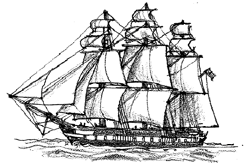1. That Was Then, This Is Now…A Brief History of the World From the
Perspective of Oceanographers.
Students create a timeline depicting the history of European and Mediterranean peoples’ interactions with the sea.  2. Meanwhile, in the Pacific…Where Did the Polynesians Come From?
Students read and compare two theories about the origins of the people who colonized the islands in the Pacific.
2. Meanwhile, in the Pacific…Where Did the Polynesians Come From?
Students read and compare two theories about the origins of the people who colonized the islands in the Pacific.  3. Meanwhile, in the Pacific…Where Did the Polynesians Come From?
Part 2 -Polynesian navigation.
Two journal articles describe efforts to learn and practice Polynesian navigation.
3. Meanwhile, in the Pacific…Where Did the Polynesians Come From?
Part 2 -Polynesian navigation.
Two journal articles describe efforts to learn and practice Polynesian navigation.  4. Charles Darwin
Students read and interpret an article about Darwin’s voyage aboard the Beagle and the development of his ideas.
4. Charles Darwin
Students read and interpret an article about Darwin’s voyage aboard the Beagle and the development of his ideas.  5. Explorers of the Ocean Depths: The Challenger Expedition of 1872-1876
Students read and interpret an article about the first major scientific expedition to systematically gather data about the oceans.
5. Explorers of the Ocean Depths: The Challenger Expedition of 1872-1876
Students read and interpret an article about the first major scientific expedition to systematically gather data about the oceans.  6. Animals!
Students learn how scientists such as those on the Challenger, classify organisms. They observe and group marine animals and become familiar with major marine invertebrate phyla.
6. Animals!
Students learn how scientists such as those on the Challenger, classify organisms. They observe and group marine animals and become familiar with major marine invertebrate phyla.  7. The Sting- Cnidaria
This reading and puzzle provide an overview of characteristics and representative animals of the phylum Cnidaria.
7. The Sting- Cnidaria
This reading and puzzle provide an overview of characteristics and representative animals of the phylum Cnidaria.  8. The Shelled Animals- Mollusca
Students read and answer questions about the phylum Mollusca and the five classes into which the molluscs have been classified.
8. The Shelled Animals- Mollusca
Students read and answer questions about the phylum Mollusca and the five classes into which the molluscs have been classified.  9. The Jointed-Foot Animals- Arthropoda
This reading describes the characteristics common to all arthropods and introduces the major marine classes and orders.
9. The Jointed-Foot Animals- Arthropoda
This reading describes the characteristics common to all arthropods and introduces the major marine classes and orders.  10. The Spiny-Skin Animals- Echinodermata
Students use a reading about echinoderms to solve a word puzzle.
10. The Spiny-Skin Animals- Echinodermata
Students use a reading about echinoderms to solve a word puzzle.  11. Urchins
Students observe the structures and behaviors of a living urchin and then observe the fertilization and development of larval urchins. A bioassay technique using sand dollar gametes is included as a possible extension.
11. Urchins
Students observe the structures and behaviors of a living urchin and then observe the fertilization and development of larval urchins. A bioassay technique using sand dollar gametes is included as a possible extension.  12. “Starfish Threaten Pacific Reefs” – Three Level Guide
This journal article describes the effects the voracious crown-of-thorns sea star has on coral animals in tropical reefs.
12. “Starfish Threaten Pacific Reefs” – Three Level Guide
This journal article describes the effects the voracious crown-of-thorns sea star has on coral animals in tropical reefs.  Production Credits
Production Credits
Below, you’ll find helpful resources for use with the above activities.
Unit I: Resources
Activity 1 That Was Then, This is Now… extension activities
We Care About Oceans Slide Show
 Slide Script
Themes
Oceans Activities
Bibliography
Glossary
National. Wildlife Federation Creed
Message from NWF Vice President
Introduction
Credits
About the National Wildlife Federation
National Wildlife Federation Explorers slide show
Slide Script
Themes
Oceans Activities
Bibliography
Glossary
National. Wildlife Federation Creed
Message from NWF Vice President
Introduction
Credits
About the National Wildlife Federation
National Wildlife Federation Explorers slide show
 Slide Script
Explorers information
Activity 3 Meanwhile, in the Pacific…
Navigating without instruments
Art of Polynesian navigation
Activity 5 Explorers of the Ocean Depths
Ocean explorers
Activity 6 Animals!
Root words
Activity 11 Urchins
Sea urchin development
Starfish photos
Slide Script
Explorers information
Activity 3 Meanwhile, in the Pacific…
Navigating without instruments
Art of Polynesian navigation
Activity 5 Explorers of the Ocean Depths
Ocean explorers
Activity 6 Animals!
Root words
Activity 11 Urchins
Sea urchin development
Starfish photos
“ ” Icon made by Pixel perfect from www.flaticon.com ” Icon made by Pixel perfect from www.flaticon.com
|













